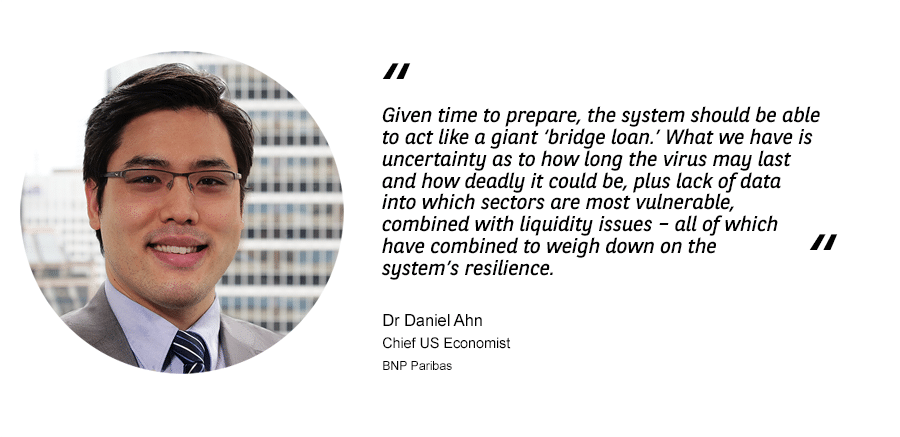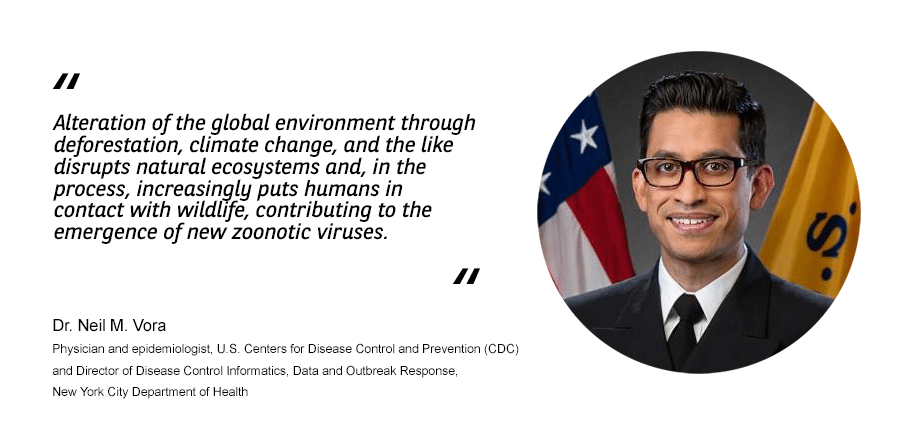As the Covid-19 outbreak escalates around the world, business
leaders and healthcare professionals alike are moving quickly in an effort to
contain the potentially catastrophic economic and medical impacts stemming
from the novel virus.
Dr Neil M. Vora, physician and epidemiologist at the U.S. Centers
for Disease Control and Prevention (CDC) and the Director of Disease Control
Informatics, Data and Outbreak Response for the New York City Department of
Health, joins a special BNP Paribas-hosted
discussion in New York on March 20, 2020. Vora speaks about ongoing
initiatives ranging from promoting social distancing to proactively countering
harmful misinformation. Joining Vora from BNP Paribas are moderator Dr. Daniel
P. Ahn, Chief US Economist and Head of Markets 360 – North America, and Greg
Boutle, Head of US Equity & Derivative Strategy, who assesses the historic
plunge in global equities in the wake of the outbreak, as well as possible
remedies in the making.
CDC: separating fact from fiction
The current outbreak may behave differently from previous disease outbreaks, according to Dr. Vora. “The likelihood of a vaccine arriving within 12-18 months will change the dynamics of pathogen transmission,” he explains, “yet at the same time we have to be open to the possibility that the virus could mutate in unexpected ways.”As in earlier pandemics, initial Covid-19 cases were genetically identified within people having direct exposure to a live-animal environment, says Dr. Vora. “Alteration of the global environment through deforestation, climate change, and the like disrupts natural ecosystems and, in the process, increasingly puts humans in contact with wildlife, contributing to the emergence of new zoonotic viruses. This calls for interdisciplinary solutions to better balance how we interact with the natural world.”
Nonetheless, rumours and conspiracy theories persist, particularly on social media. These rebuttals against established findings are themselves a major threat to health. “Misinformation around vaccines, for instance, have kept large swaths of the population exposed to other illnesses,” adds Vora. “Even now we are seeing conspiracy theories about the likely origins of the virus, even though the preponderance of evidence indicates the illness occurred naturally in animals and subsequently spilled over into the human population.”
Dr. Vora says it is vital to remain focused on the facts. “It is vital to remain focused on the facts”.
Liquidity, liquidity, liquidity: financial ramifications
The strain on the world’s economies and financial markets has been swift and brutal. With social and economic activity grinding to a halt, many businesses are facing liquidity constraints, with even staunch fiscal conservatives backing government intervention.In the US, Senate lawmakers finalized a $2 trillion “Phase 3” stimulus package, including direct payments to all Americans (with certain income stipulations), hundreds of billions of dollars in loan guarantees to small businesses, and backstops for hard-hit industries.
Financial institutions are, however, on a much firmer footing following the far more stringent capital-adequacy and liquidity standards in place since the 2008 crisis. According to the New York Federal Reserve, the largest banks held some $1.69 trillion in cash and savings accounts in Q3 2019 (compared to only $590bn in Q3 2008). Combined with an estimated $1.55 trillion in cash holdings among domestic non-financial firms, according to Moody’s, Dr. Ahn estimates there is theoretically sufficient liquidity in the system to cover cashflow shortfalls for a few years.

While the financial system may theoretically have sufficient liquidity, it lacked ample advance warning, according to Dr. Ahn. “Given time to prepare, the system should be able to act like a giant ‘bridge loan,'” he explains – particularly if there is consensus that the crisis can be contained within a reasonable timeframe. Instead, “what we have is uncertainty as to how long the virus may last and how deadly it could be, plus lack of data into which sectors are most vulnerable, combined with liquidity issues – all of which have combined to weigh down on the system’s resilience.”
At this stage of the crisis, it is becoming increasingly clear that financial – and perhaps even political – innovation will be necessary to ensure proper absorption of current and near-term market shocks.
“The problem rests as much with the rapid and effective reallocation of capital from cash-rich sectors to those that need it most,” says Dr. Ahn. While the Fed has encouraged banks to draw down their capital buffers for the provision of credit, “with enough mass-panic and cash-hoarding behaviour, unintended consequences could arise.”
Looking forward
All of which leads back to the inevitable intersection of finance and health – and doing what is needed to reduce the pressure on healthcare providers and business leaders around the world.“Without having all of the information to make exact determinations, it’s impossible to say how long these social-distancing measures will be in place,” Dr. Vora explains. “Which again underscores our need for information from reliable sources – and the need to follow protocols such as working from home, as well as minimising in-person meetings and exposure to others.”

